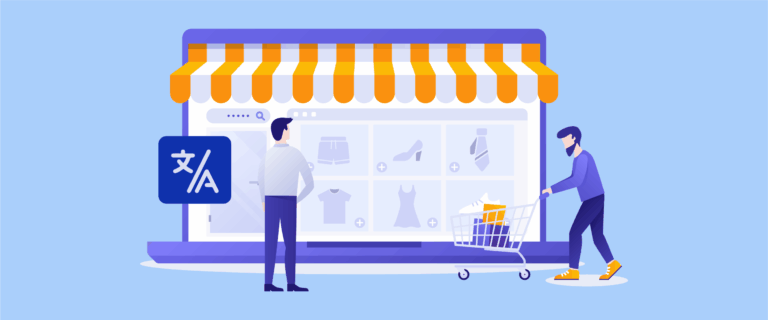Fixing canonical tag conflicts on multi-domain translated websites is one of the biggest challenges in managing international SEO. Incorrect or inconsistent canonical tags can confuse search engines when determining the main page, trigger duplicate content, and lower organic performance. On multilingual sites with a multi-domain structure, this problem becomes even more complex because each domain carries variations in language, URL, and similar content.
To overcome this, more than just manual configuration is required. With the right strategy, international websites can avoid canonical conflicts and continuously improve global visibility.
What are canonical tag conflicts?
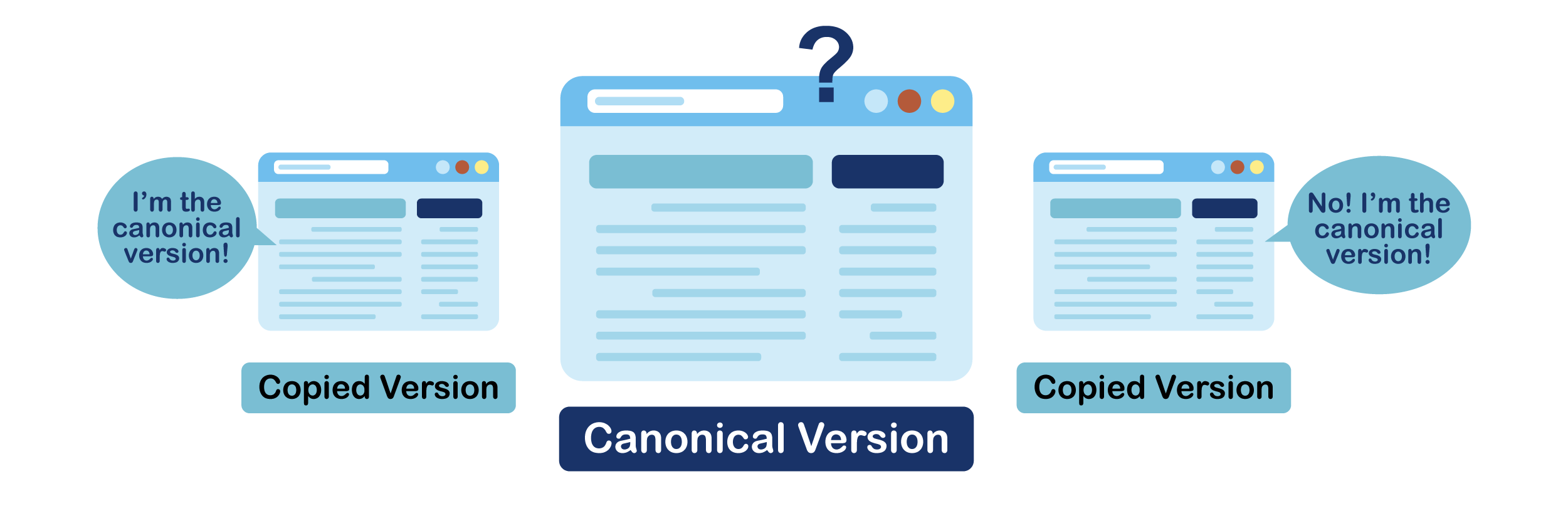
A canonical tag is a small piece of code on a website page that tells search engines which page is the main version. Problems arise when these tags are inconsistent or misdirected. For example, one page says the main version is on domain A, while another page points to domain B with the same content. This confusion is called a canonical tag conflict.
This conflict is like receiving two addresses for the same house for search engines. As a result, search engines may incorrectly select which page to display in search results or even consider it duplicate content. If left unresolved, canonical tag conflicts can reduce website visibility, lower SEO rankings, and prevent important pages from appearing as intended.
Why canonical tags matter for multilingual SEO?
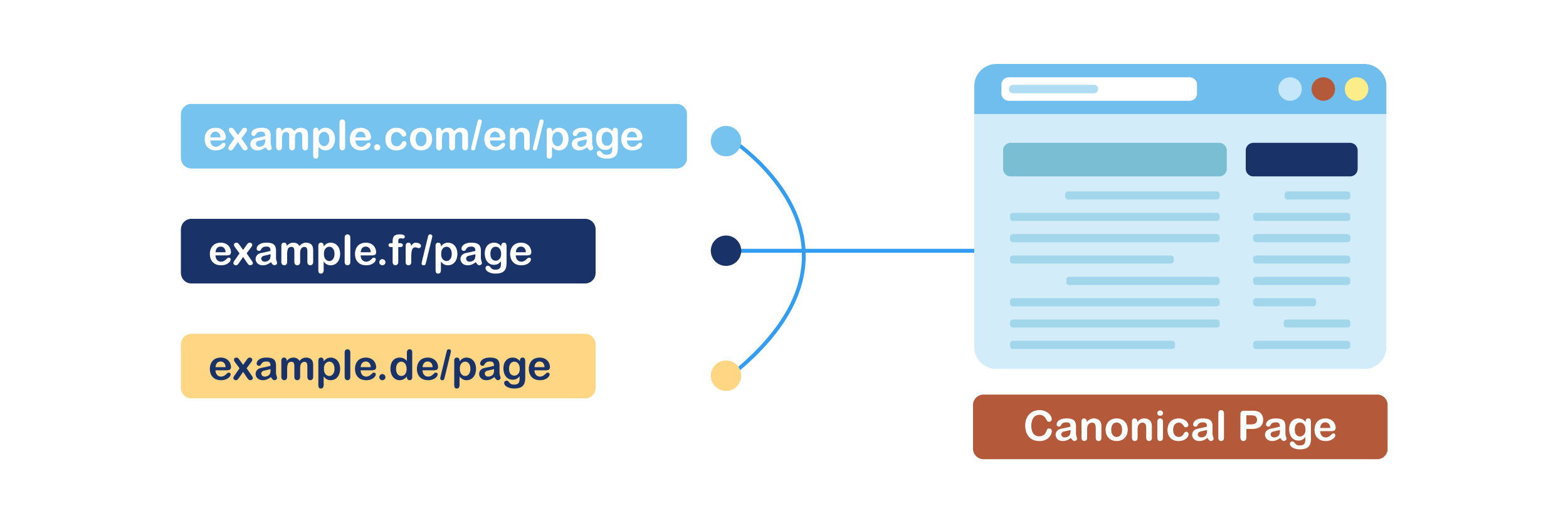
In multilingual SEO, canonical tags ensure search engines understand which page version should be prioritized. Without the correct settings, content in different languages or domains can be considered duplicate. Here are some reasons why canonical tags are so important:
- Avoiding duplicate content: Search engines don’t need to guess which page is the main if the canonical is clear. This prevents penalties or ranking drops due to being considered duplicate content.
- Ensuring the main page is indexed: With the right canonical, search engines will select the main page according to the target language or country. This helps content appear to the right audience.
- Supporting international SEO strategies: Consistent canonical tags strengthen multi-domain structures, so search engines see each page as part of a global strategy rather than competing content.
- Optimizing SEO authority distribution: Inbound backlinks and SEO signals are not divided among similar pages but consolidated on the main canonical page.
How multi-domain setups cause duplicate content issues

Multi-domain multilingual websites are effective for reaching a global audience, but at the same time, they are prone to duplicate content problems. Search engines often struggle to identify the main version of a page when similar content appears across multiple domains. If not handled properly, this can lower SEO rankings and cause the website to lose visibility in its target markets.
Identical content across multiple domains
When the same content is published in the same language across several domains, search engines may interpret it as duplication. For example, a main site and its regional counterpart might both display an English product page with almost identical text. Without the right canonical or hreflang setup, Google has difficulty determining which version to prioritize.
The impact is that the page that should rank highly ends up competing with another one of your own domains. As a result, SEO authority is diluted, rankings drop, and organic traffic potential decreases because the search engine randomly selects which version to display.
Overlapping translations between domains
Overlapping translations are common in multi-domain multilingual sites. For instance, the Malaysia and Singapore domains may present an English page with only minor variations. While humans see the differences, search engines often treat them nearly identical.
This weakens SEO signals and can cause Google to flag one of them as duplicate content. The impact is that one domain may lose visibility in its intended market because search engines choose not to display the version tailored for the right audience.
Inconsistent canonical implementation
Many multi-domain websites fail to maintain consistent canonical tags across domains. For example, a page on the Spanish-language domain might mistakenly set its canonical tag to the English version. This misconfiguration confuses search engines about which page should be indexed as the main one.
As a result, translated pages lose ranking opportunities in local markets because they are effectively redirected to another domain. Over time, this can drastically reduce organic traffic potential, even though the local market is supposed to be a primary target.
Duplicate metadata and URL structures
Beyond page content, identical metadata and URL structures across domains can also trigger duplicate content issues. For instance, all domains might use the same slug /about-us/ without language or country differentiation. Search engines interpret this repetition as redundancy.
The impact is reduced SEO credibility because Google perceives the site as lacking uniqueness. Instead of strengthening global authority, this flawed structure makes each domain compete against the others, ultimately weakening the overall performance of the international website.
Automated approaches to fix canonical tag issues

Manually handling canonical tags across multiple domains and languages quickly becomes unmanageable as a website scales. Automated approaches allow webmasters to maintain consistency, reduce human error, and resolve duplicate content conflicts more effectively. By using scalable tools and workflows, international websites can ensure search engines always recognize the correct version of a page.
Implementing scalable automation
Scalable automation means setting up systems that can manage canonical tags across hundreds or thousands of pages without manual input. This often involves deploying scripts, CMS plugins, or SEO automation platforms that automatically insert the right canonical tag based on predefined rules. With this approach, even newly published pages get the correct canonical tag from day one.
For example, an e-commerce site with thousands of product pages in multiple languages could use an automated script that ensures every product variant points back to the correct primary product URL. This prevents the site from competing against itself in search rankings.
Positioning automation tools
Automation translation tools designed for multilingual SEO, such as Linguise or custom-built SEO management platforms, simplify canonical tag management by handling complex site architectures. These tools allow businesses to focus on content quality and localization while leaving technical SEO consistency to the automation system.
For example, a Linguise blog article in Japanese will automatically have a canonical tag. Using the Linguise service, the article will immediately have a self-referencing canonical that points to the URL of the article in Japanese itself.

Dynamic canonical tag generation for each language and domain
Dynamic generation involves creating canonical tags automatically depending on a page’s domain, language, or region. This ensures that each localized page points to itself or the correct version, rather than a default domain. It prevents cross-domain conflicts where translated content mistakenly references another language version as the canonical.
For example, an e-commerce website selling fashion items across multiple regions can configure its CMS to automatically generate canonical tags that match the language and domain of each store. That way, the French version at example.fr/robe-d-ete points to itself as the canonical in French, while the German version at example.de/sommerkleid points to itself in German.
This ensures that each localized page references its own canonical URL, rather than defaulting to the English example.com/summer-dress.
Centralized rule-based management
Centralized rule-based systems let SEO teams create unified rules for canonical tags across all domains. Instead of editing each page individually, the rules apply globally, such as “all blog posts in subdomains should reference the main blog domain” or “translated versions must always self-reference as canonical.”
For example, a company with dozens of microsites could maintain one central SEO management system. By applying rule-based logic, canonical tags across all microsites remain aligned, ensuring no single site is mistakenly deprioritized by search engines.
Integrating canonical fixes with translation workflows
Canonical issues often arise during translation or content rollout in multilingual setups. By integrating canonical checks into translation workflows, the risk of misconfiguration drops significantly.
Every new page published in another language can automatically receive the correct canonical, avoiding common mistakes such as leaving translated pages without canonicals or pointing them to the wrong version. Tools like Linguise combine automated translation with SEO consistency, ensuring that each localized page carries the right canonical tag from the moment it goes live.
Leveraging AI and machine learning for pattern detection
AI and machine learning can identify recurring canonical issues that human teams might overlook. These technologies analyze large-scale site data to detect patterns such as missing tags, misdirected canonicals, or unexpected duplicate content clusters. By predicting potential conflicts, AI helps prevent problems before they spread across multiple domains.
For example, an AI-powered SEO monitoring tool could scan millions of pages across an multilingual e-commerce platform and flag anomalies, like French product pages pointing to English canonicals. The system then suggests fixes or automatically applies corrections at scale.
Monitoring and maintenance strategies for canonical tags

Canonical tag management does not end after implementation. Continuous monitoring and maintenance are essential to ensure long-term success in multilingual and multi-domain setups. Without ongoing oversight, errors can creep back in, causing duplicate content issues and affecting search visibility. Below are key strategies to keep canonical tags accurate and effective over time.
Continuous monitoring with SEO crawlers
Regularly using SEO crawlers allows websites to identify canonical inconsistencies across multiple pages and domains quickly. These tools simulate how search engines scan your site, helping you detect missing or misconfigured tags before they impact indexing. By setting a schedule, you can spot and fix problems early.
Moreover, monitoring with crawlers ensures that even after new pages are added or old ones updated, canonical tags remain aligned with your SEO strategy. This proactive step helps prevent search engines from indexing duplicate versions of the same content.
Example: A global e-commerce brand runs weekly crawls using tools like Screaming Frog or Sitebulb to detect whether product pages across domains have the correct canonical pointing to their localized versions.
Automating alerts for canonical tag errors
Setting up automated alerts helps SEO teams respond quickly when canonical issues arise. Alerts can be configured to notify you when crawlers detect missing tags, conflicts, or duplicate references. This reduces the chance of errors going unnoticed for weeks or months.
Automation also reduces manual workload, ensuring that your team doesn’t have to monitor reports constantly. Instead, they get notified instantly when something goes wrong, allowing them to take immediate corrective actions.
Example: A SaaS company integrates alerts from SEMrush and Google Data Studio dashboards to flag sudden increases in duplicate content caused by broken canonical tags.
Regular SEO audits and crawl analysis
Regular SEO audits ensure that canonical tags align with your site’s growth. Audits provide deeper insights beyond surface-level checks, uncovering hidden conflicts such as self-referencing issues or mismatched hreflang and canonical pairs.
Crawl analysis during audits helps detect technical errors introduced during redesigns, migrations, or plugin updates. This keeps your SEO health in check and avoids major disruptions to search rankings.
You can use various tools, such as SEMrush, to check whether duplicate content issues exist. Below is an example of a site audit result, which shows several duplicate content issues that must be resolved.
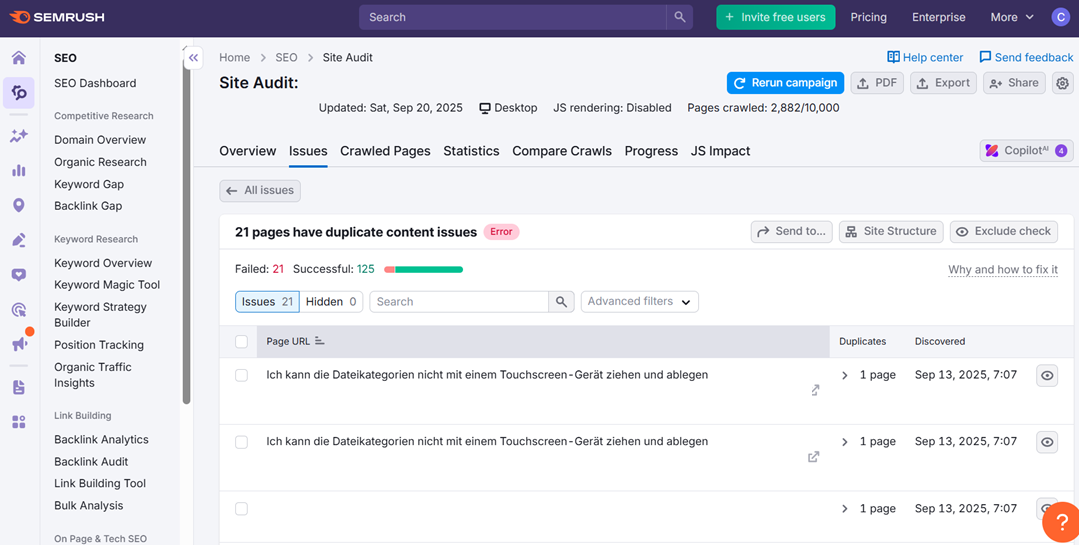
Tracking performance across multiple domains
Monitoring how canonical tags affect SEO performance is as important as checking their configuration. By tracking ranking, traffic, and indexation across different domains, you can measure whether canonical implementation is boosting visibility or causing issues.
This analysis also provides insights into whether search engines respect your canonical signals. If certain localized versions are underperforming, it might indicate conflicts between hreflang and canonical tags.
Example: An international blog monitors organic traffic via Google Analytics and compares performance across country-specific domains to ensure canonical signals are helping each site grow.
Updating canonical tags during site changes
Website updates, such as adding new content, changing URL structures, or merging domains, can easily disrupt canonical consistency. That’s why updating canonical tags is essential whenever these changes occur. Ignoring this can lead to outdated or broken signals.
Proactively aligning canonical updates with development or content release cycles ensures that search engines always see the correct content version. This minimizes the risk of duplicate indexing and ranking loss.
Example: An educational platform updates canonical tags after a site redesign where course URLs were restructured, preventing duplicate versions from competing in search results.
Validation with Google Search Console
Google Search Console (GSC) is an important tool for validating canonical tags because it shows how Google interprets your signals compared to what you have set. If Google chooses a different canonical tag, it is a sign that your configuration needs to be corrected. Checking GSC reports regularly ensures that your intended signals match Google’s indexing behavior, especially for multilingual and multi-domain websites.
Here is an example of the “Duplicate without user-selected canonical” view in Google Search Console, which shows when Google finds similar pages without a clear canonical tag from the user.
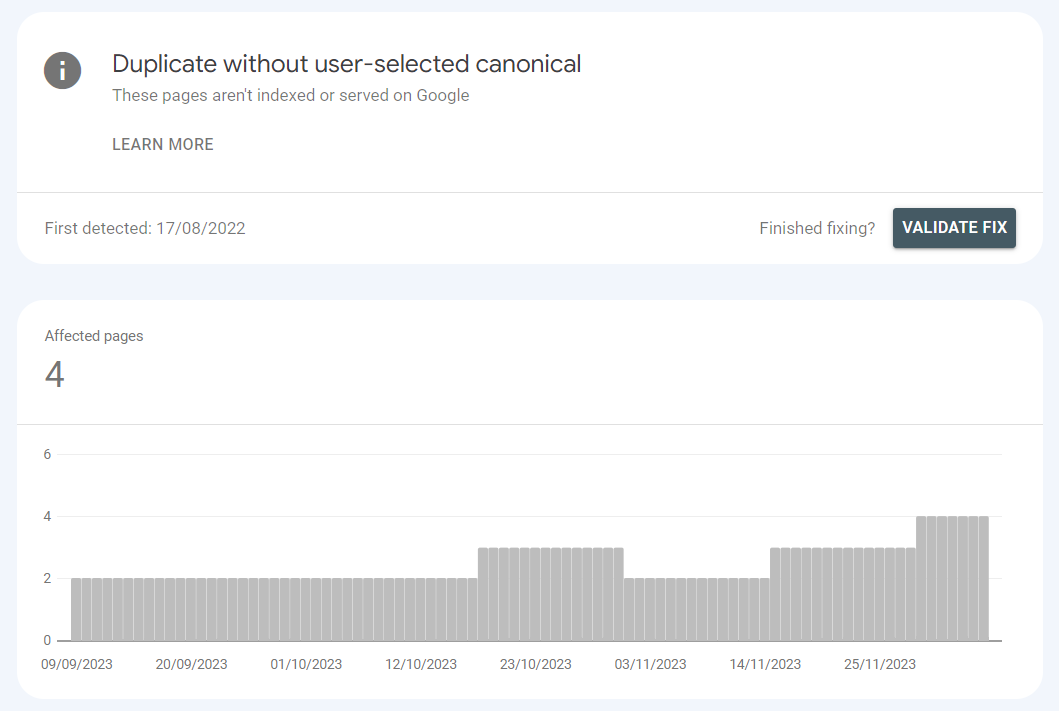
Conclusion
Fixing canonical tag conflicts on multi-domain translated websites is essential to maintaining strong international SEO performance. Without consistent canonical signals, search engines may misinterpret duplicate pages, dilute rankings, and reduce visibility in target markets. By combining automation, monitoring, and strategic rule-setting, businesses can ensure that their multilingual and multi-domain sites remain clear, organized, and optimized for global audiences.
Investing in solutions that integrate seamlessly with translation workflows is key to achieving scalable and reliable results. Tools like Linguise simplify canonical tag management and enhance overall multilingual SEO strategies. If you’re ready to streamline your international SEO and prevent duplicate content issues, try Linguise and see how it transforms your global website performance.


